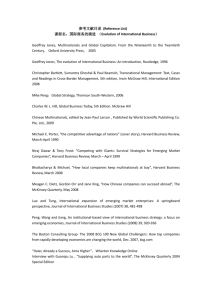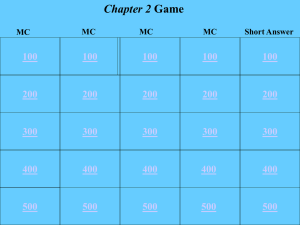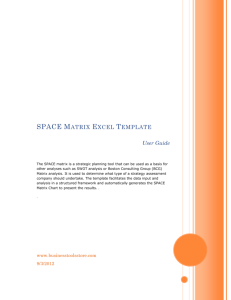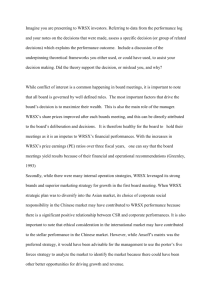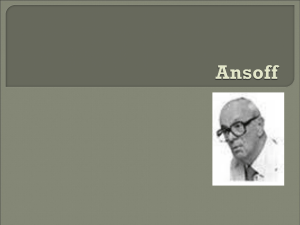Methods of strategic analysis and proposal method of
advertisement
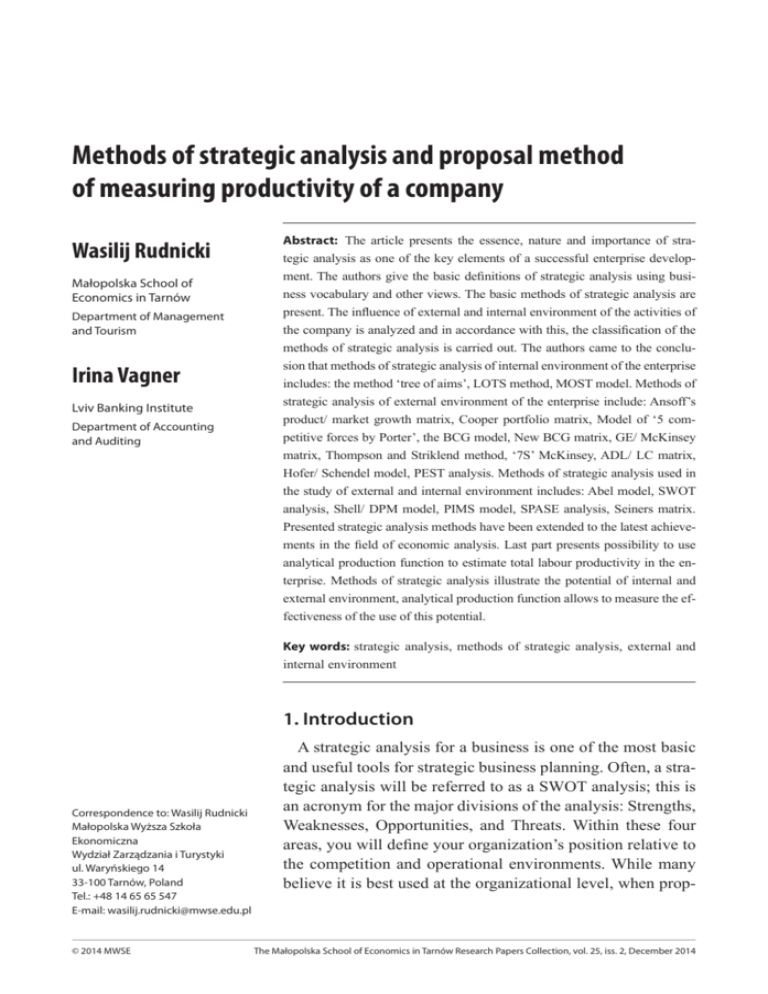
Methods of strategic analysis and proposal method of measuring productivity of a company Wasilij Rudnicki Małopolska School of Economics in Tarnów Department of Management and Tourism Wasilij Rudnicki, Irina Vagner Lviv Banking Institute Department of Accounting and Auditing Abstract: The article presents the essence, nature and importance of strategic analysis as one of the key elements of a successful enterprise development. The authors give the basic definitions of strategic analysis using business vocabulary and other views. The basic methods of strategic analysis are present. The influence of external and internal environment of the activities of the company is analyzed and in accordance with this, the classification of the methods of strategic analysis is carried out. The authors came to the conclusion that methods of strategic analysis of internal environment of the enterprise includes: the method ‘tree of aims’, LOTS method, MOST model. Methods of strategic analysis of external environment of the enterprise include: Ansoff’s product/ market growth matrix, Cooper portfolio matrix, Model of ‘5 competitive forces by Porter’, the BCG model, New BCG matrix, GE/ МcKinsey matrix, Thompson and Striklend method, ‘7S’ McKinsey, ADL/ LC matrix, Hofer/ Schendel model, PEST analysis. Methods of strategic analysis used in the study of external and internal environment includes: Abel model, SWOT analysis, Shell/ DPM model, PIMS model, SPASE analysis, Seiners matrix. Presented strategic analysis methods have been extended to the latest achievements in the field of economic analysis. Last part presents possibility to use analytical production function to estimate total labour productivity in the enterprise. Methods of strategic analysis illustrate the potential of internal and external environment, analytical production function allows to measure the effectiveness of the use of this potential. Key words: strategic analysis, methods of strategic analysis, external and internal environment 1. Introduction Correspondence to: Wasilij Rudnicki Małopolska Wyższa Szkoła Ekonomiczna Wydział Zarządzania i Turystyki ul. Waryńskiego 14 33-100 Tarnów, Poland Tel.: +48 14 65 65 547 E-mail: wasilij.rudnicki@mwse.edu.pl © 2014 MWSE A strategic analysis for a business is one of the most basic and useful tools for strategic business planning. Often, a strategic analysis will be referred to as a SWOT analysis; this is an acronym for the major divisions of the analysis: Strengths, Weaknesses, Opportunities, and Threats. Within these four areas, you will define your organization’s position relative to the competition and operational environments. While many believe it is best used at the organizational level, when prop- The Małopolska School of Economics in Tarnów Research Papers Collection, vol. 25, iss. 2, December 2014 176 Wasilij Rudnicki, Irina Vagner erly implemented, a SWOT analysis will often return targeted, productive results at division or departmental levels of business (Sharrieff, 2012). There are many definitions of strategic analysis, for example, strategic analysis is: –– ‘the process of conducting research on the business environment within which an organization operates and on the organization itself, in order to formulate strategy’ (BNET Business Dictionary); –– ‘a theoretically informed understanding of the environment in which an organization is operating, together with an understanding of the organization’s interaction with its environment in order to improve organizational efficiency and effectiveness by increasing the organization’s capacity to deploy and redeploy its resources intelligently’ (Worrall, 1998, pp. 3–4). Definitions of strategic analysis often differ, but the following attributes are commonly associated with it: –– identification and evaluation of data relevant to strategy formulation; –– definition of the external and internal environment to be analyzed; –– a range of analytical methods that can be employed in the analysis. Examples of analytical methods used in strategic analysis include: –– SWOT analysis; –– PEST analysis; –– Porter’s five forces analysis; –– four corner’s analysis; –– value chain analysis; –– early warning scans; –– war gaming (Downey, 2012). After examining the nature and importance of strategic analysis, in our view, it is necessary to consider its methods. By carrying out a detailed analysis of existing methods of strategic analysis, we proposed to classify them depending on the environmental factors which influence it (Figure 1). Methods of strategic analysis and proposal method of measuring productivity of a company Methodsofstrategicanalysisof internalenvironmentofthe enterprise •The •The method method ‘tree ‘treeof ofaims’ aims’ •LOTS •LOTS method method •MOST •MOST model model Methodsofstrategicanalysisof externalenvironment ofthe enterprise •Ansoff’sproduct/ product/market marketgrowth growthmatrix matrix •Ansoff’s •Cooperportfolio portfolio matrix •Cooper matrix •Modelofof‘5‘5competitive competitiveforces forcesbybyPorter’ Porter’ •Model •TheBCG BCGmodel model •The •NewBCG BCGmatrix matrix •New •GE/ •GE/МcKinsey МcKinseymatrix matrix •Thompson •Thompsonand andStriklend Striklendmethod method ••‘7S’ ‘7S’McKinsey McKinsey •ADL/ •ADL/LC LCmatrix matrix •Hofer/ •Hofer/Schendel Schendelmodel model •PEST •PESTanalysis analysis Methodsofstrategicanalysis usedinthestudyofexternal andinternalenvironment 177 •Abell model model •Abell •SWOT analysis analysis •SWOT •Shell/ DPM DPM model model •Shell/ •PIMS model model •PIMS •SPASE •SPASEanalysis analysis •Seiners •Seiners matrix matrix Figure 1. Methods of strategic analysis S o u r c e: Authors’ own elaboration. In our opinion, it is necessary to discuss in detail each of the above methods. 2. Methods of strategic analysis of internal environment of the enterprise 2.1. The method ‘tree of aims’ The method ‘tree of aims’ is a graphic chart that demonstrates change of general aims into sub-aims. The top of chart is interpreted as aims, ribs or arches, as a copula between the aims. The method ‘tree of aims’ is the main universal method of system analysis. The ‘tree of aims’ comes forward as systematization of hierarchy of aims that represents their collateral subordination and interconditionality. 2.2. LOTS method LOTS method includes a detailed, sequential discussion of a number of business issues at different levels and varying degrees of complexity: from the corporate mission of the enterprise as a whole to the individual project in its middle. Discussion includes nine stages and refers to the 178 Wasilij Rudnicki, Irina Vagner existing state, strategy, long-term goals, short-term objectives, methods and objects of analysis, human resources, development plans, organization of management, reporting. 2.3. MOST model MOST model clarifies to the hierarchy between the mission, strategies and objectives. According to this model, the position of a business entity is described with undefined criteria, which may include sales volume, profit margins or payment of dividends, a number of employees. 3. Methods of strategic analysis of external environment of the enterprise 3.1. The Ansoff Growth matrix The Ansoff Growth matrix is another marketing planning tool that helps a business determine its product and market growth strategy. Ansoff’s product/ market growth matrix suggests that a business’ attempts to grow depending on whether it markets new or existing products in new or existing markets. The output from the Ansoff product/ market matrix is a series of suggested growth strategies which set the direction for the business strategy. These are described below: market penetration, market development, product development, diversification. 3.2. Cooper portfolio matrix Cooper portfolio matrix defines the criteria for selection of the enterprise strategy: –– The attractiveness of industry, which, in turn, is determined by the market attractiveness and technological level. –– „Business Force” that is also determined by market advantages of commodity and synergistic effect of the enterprise in technology of production and marketing. 3.3. Model of 5 competitive forces by Porter To identify the contribution of the enterprise at the market and the level of profits Porter identified five competitive forces: new competitors who get into the industry and produce similar goods, existing competitors in the industry; the threat from the side of substitute products (substitutes), the impact of buyers’ strength; influence of suppliers. Porter identified three main strategies that are universal and can be applied to the above competitive forces: –– Leadership strategy. It directs the company to manufacture big quantities of goods at the large market. –– Strategy of product differentiation is used when the enterprise enters a deep market with a unique product. –– Focus strategy focuses on one segment of the market or on the limited geographic market sector. Methods of strategic analysis and proposal method of measuring productivity of a company 179 3.4. The BCG Strategic Portfolio Model It is a method of approaching and analyzing business marketing and growth developed by the Boston Consulting Group. The primary guiding principle of the BCG group’s strategy is that experience in a market share leads to reduced costs and higher profits. This model uses the BCG marketing matrix, a system to classify business enterprises based on their potential for profits and growth. The model also applies mathematical formulas to business enterprises or products to calculate potential growth and earnings. The BCG growth matrix part of the model classifies each product as a ‘cash cow’, ‘problem child’, ‘star’ or ‘dog’. ‘Cash cows’ represent product lines that bring in a high income at low cost to the company, leaving plenty of money to put to other uses. ‘Star’ product lines may bring in some profits but require more investment to maintain their market share. These are products with the potential to become future ‘cash cows’ if the company invests in them wisely. ‘Problem children’ do not generate cash flow and require more investment but still have potential to grow. These are the products to watch, as they can eventually become either ‘stars’ and then ‘cash cows’ or ‘dogs’. ‘Dog’ products may generate some income or loss but have slow-growing markets, making them poor continuing investments for a company’s dollar (Hirsh, 2014). 3.5. New BCG matrix New BCG matrix is used to characterize the products (services), which the enterprise provides. In this model, two factors are interacted: number of competitive advantages of products (services) and the importance of competitive advantages in general. 3.6. GE/ McKinsey matrix McKinsey & Company developed a nine-cell portfolio matrix as a tool for screening GE’s large portfolio of strategic business units (SBU). This business screen became known as the GE/ McKinsey matrix and is shown below: The GE/ McKinsey matrix is similar to the BCG growth-share matrix in that it maps strategic business units on a grid of the industry and the SBU’s position in the industry. The GE matrix, however, attempts to improve upon the BCG matrix in the following two ways: –– The GE matrix generalizes the axes as ‘Industry Attractiveness’ and ‘Business Unit Strength’ whereas the BCG matrix uses the market growth rate as a proxy for industry attractiveness and relative market share as a proxy for the strength of the business unit. –– The GE matrix has nine cells vs four cells in the BCG matrix. 3.7. Thompson and Striklend method Thompson and Striklend method foresees the choice of alternatives of corporate level depending on two parameters: rates of market growth (rapid or slow) and competitive position of enterprise (strong or weak). Possible strategic alternatives in the fields of the matrix are placed in order to reduce their attractiveness. 180 Wasilij Rudnicki, Irina Vagner According to this model, on the X axis the competitive position of business is estimated and on the Y axis—the dynamics of market growth. There are given strategies in the four quadrants of the matrix, each of which specifies the provision of strategic business units in the two measured spaces of matrix. 3.8. ‘7S’ McKinsey model ‘7S’ McKinsey model is a way of understanding the major internal factors, influencing its present situation and future development. A conceptual diagram of this model includes seven factors for success of business entities: strategy, skills, generally accepted values (shared values), structure, system, staff, cultural identity (style). 3.9 ADL/ LC matrix The concept of the life cycle of the field consistently passes four stages: nucleation, growth (or development), maturity, aging (decline). The main theoretical provision of ADL/ LC model is that a separate kind of business and any business entity may be located on one of these life cycle, and therefore it is necessary to analyze it within that stage. 3.10 Hofer/ Schendel model Hofer/ Schendel model is concentrated on the positioning of existing businesses in the matrix of the goods development and determination of ideal set development. It should be noted that there are only two optimal sets of business: buying a new or sale of the old type of business, however, the situation of each business is determined according to the degree of market development and its performance according to competitors. 3.11. PEST analysis PEST analysis (STEP, SLEPTE, STEEPLD-analysis) is a description of factors of four groups: social, technological, economic and political. Some authors often add: ecology (E), legislation (L), demographics (D) to the above mentioned four factors. 4. Methods of strategic analysis used in the study of external and internal environment 4.1. Abell model Abell model, in fact, has corrected shortcomings of Ansoffa model. The Abell model is a three-dimensional model for defining the business of the company and finding areas for growth and diversification along its axis. The company’s mission is created with three strategic questions to be answered: –– Who is our target customer group? –– What function do we provide to the customer? –– How do we provide that function (technology)? Methods of strategic analysis and proposal method of measuring productivity of a company 181 These issues come together in the Abell model. In Abell model we look at three dimensions: –– Market Group Dimension. Whom are we serving? –– Problem-Solving Dimension. In which needs will we provide? –– Technology Dimension. How do we provide in the needs? 4.2. SWOT-analysis SWOT-analysis is one of the most famous methods of strategic analysis, which is being made in view of factors of both external and internal environment, which in turn makes it possible to evaluate existing opportunities and potential threats of the company, to develop a strategy for the further development. SWOT stands for: –– Strengths (What are the positive attributes of your company, product or service?) –– Weaknesses (What are the negative attributes of your company, product or service?) –– Opportunities (Where are the market opportunities for your product or service?) –– Threats (What are the main threats for your company?) Before starting the analysis, you need to have completed your marketing research plan and analyzed your competitive marketing strategy. Once you have identified the strengths, weaknesses, opportunities and threats, then use those to prioritize your marketing strategies and focus, by asking the above questions. 4.3. Shell/ DPM model Fundamental idea of Shell/ DPM model is that the overall enterprise strategy should ensure the maintenance of balance between the cash surplus and the deficit through the development of new promising businesses based on the latest scientific and technological developments that will absorb excess of money supply, which are in the maturity phase of the life cycle. 4.4. PIMS model PIMS model (Profit Impact of Market Strategy)—method of analyzing the impact of market strategy on profit. This model provides determination of quantitative patterns of factors influence on outcomes of business entities (profitability, profits) arising from the analysis of empirical experience of the potential operation of a large number of industrial enterprises. 4.5. SPACE analysis SPACE analysis (Strategic Position and Action Evaluation); SPACE method (evaluation of strategic assessment of actions) is a comprehensive method for analysis of the position in the market and choosing the optimal strategy for medium and small enterprises. The analysis assesses the internal and external environment and allows to design an appropriate strategy. The analysis describes the external environment using two criteria: 182 Wasilij Rudnicki, Irina Vagner –– Environmental Stability (ES)—it is influenced by the following subfactors: technological change, inflation rate, demand volatility, price range of competitive products, price elasticity of demand, pressure from the substitutes; –– Industry Attractiveness (IA)—it is influenced by the following subfactors: growth potential, profit potential, financial stability, resource utilization, complexity of entering the industry, labour productivity, capacity utilization, bargaining power of manufacturers. The inside environment is also described by two criteria: –– Competitive Advantage (CA)—it is influenced by the following factors: market share, product quality, product lifecycle, innovation cycle, customer loyalty, vertical integration, –– Financial Strength (FS)—it is influenced by the following indicators: return on investment, liquidity, debt ratio, available versus required capital, cash flow, inventory turnover. 4.6. Seiners matrix Seiners matrix (model ‘product/ market’) includes: classification of markets and products on existing markets, new products, but they are related to existing markets. This model is used to determine the probability of success in choosing one or another type of business and for choosing between different types of businesses. 5. Analytical production function The success of a company depends not only on the ability to identify internal and external environment but above all the ability to exploit the potential of the environment. Thanks to innovative activities we can achieve high economic and financial effects (Kozioł et al., 2013a). To measure economic productivity analytical production function can be applied. This function uses a natural approach based on cost calculation. It presents the production function with seven specified arguments. The analytical form of production function divides operating costs into compensation understood as labour costs (W) and non-compensation costs (Km) decreased by risk-related costs (Kr). This differentiation introduces the annual asset wear and tear rate (z), the asset impairment rate (s) and the level of pay for–human capital P = (W + Km Kr) (1 + r) (u). Therefore, the production function equation can be expressed in the following way (Kozioł et al., 2013a): P = (W + Km – Kr) (1 + r) ൌݖ ൌݏ Km = z · A Kr = s · A W = u H ൌݖ ൌݏ where: Km—costs resulting from the use of assets; Km = z · A Kr—risk-related costs; W—compensation (labour costs); A—value of assets; H—staff’s human capital; u—level of pay for human capital; z—asset turnover to non-labour costs ratio; s—asset impairment in production processes. Kr = s · A W=uH (1) Methods of strategic analysis and proposal method of measuring productivity of a company 183 The analytical production function corresponds to the actual process of developing products. It describes the composition of production factors in the production process. The market value of products, on the other hand, represents the historical cost of manufacture adjusted to the cost profitability ratio (r). As a result, the system of arguments determines all significant variables, and the basic analytical form of the function, unlike in the case of other popular models, does not require parameter estimations. According to the model, the market value of production can be presented as the function of the sum of outlays. The transformed formula and the inclusion of the company’s intellectual capital (I) leads to the extended function: where: I—intellectual capital. P = (W + z · A – s · A) × (1 + r) × (1 + I) (2) The transformed formula for presenting production effect (P) as the function of labour costs results in the following formula: � � � ∙ �� � � ∙ �� � ��� ∙ �� � �� ∙ �� � �� � (3) The use of the human capital concept in the analytical production function model allows for expressing labour costs (W = u · H) as a derivative of human capital value: � � � ∙ �� � � ��� ∙ � ∙ �� � �� ∙ �� � �� � � (4) The system variables occurring in the study of the production function allows the derivation of a more compact model of production containing a synthetic variable management (Z). This variable integrates the impact of variables: z, r, i, s, u, used in the production function. As a result, the production model takes into account the variable management that can be represented as follows: ��� (5) � � � � ��� � The calculation of the variable management requires transformation of the above model, thereby resulting in variable calculation formula (Z): �� � ��∙� ∙ ln � � (6) Variable management is a tool for measuring the level of management, it shows the level of innovation and creativity during the use of resources by the company. The goal of any company should be improving this indicator. The presented concept is a general form of the cost account and it includes the category of natural loss (s) related to any business activity. Consequently, the model reflects the actual production process, being a useful management tool. 184 Wasilij Rudnicki, Irina Vagner 6. Conclusions Strategy analytics helps clients build defensible, distinctive strategies to win in complex technology markets, on a global and regional scale. Strategic analysis is the use of tools such as SWOT analysis, PEST analysis, value chain analysis and other methods with an aim of determining the best way an organization can reach the desired goals and objectives using the available resources. Measuring the effectiveness of the use of these resources is possible using the presented analytical production function. References BNET Business Dictionary [online, accessed: 2014-03-09]. Retrieved from: http://www.cimaglobal.com. Downey, J. (2012). Strategic analysis tools. Topic Gateway Series, no. 34. Prepared by Technical Information Service [online, accessed: 2014-03-12]. Retrieved from: http://www.cimaglobal.com/. Hirsh, A. (2014). What is the BCG model in marketing? [online, accessed: 2014-03-12]. Retrieved from: http://smallbusiness.chron.com/bcg-model-marketing-12953.html. Kozioł L., Pyrek R., Kozioł W., Wojtowicz A. (2013a). An outline of a compensation system based on human capital theory. Procedia. Elsevier. Kozioł L., Pyrek R., Kozioł W., Wojtowicz A. (2013b). Relationship marketing: A tool for supporting the company’s innovation process. Procedia. Elsevier. Sharrieff, M. (2012). How to write a strategic analysis for business organizations [online, accessed: 2014-03-19]. Retrieved from: http:// www. smallbusiness.chron.com/write-strategic-analysis-business-organizations-89.html. Worrall, L. (1998). Management Research Centre. Wolverhampton Business School, University of Wolverhampton, UK. Occasional paper series, 27th May 1998, no. OP 001/98. ISSN 1464-1747. Metody analizy strategicznej – propozycja metody pomiaru produktywności przedsiębiorstwa Abstrakt: Artykuł prezentuje istotę, charakter i wagę analizy strategicznej jako jednego z kluczowych elementów udanego rozwoju przedsiębiorczości. Wykorzystując terminologię biznesową, autorzy przytaczają podstawowe definicje i metody analizy strategicznej oraz prezentują różne inne poglądy. Autorzy dokonali analizy wpływu środowiska zewnętrznego i wewnętrznego na działalność firmy i biorąc pod uwagę powyższe czynniki, sklasyfikowali metody analizy strategicznej. Doszli do wniosku, że metody analizy strategicznej wewnętrznego środowiska przedsiębiorstwa obejmują: metodę „drzewko celów”, metodę LOTS oraz model MOST. Natomiast metody analizy strategicznej zewnętrznego środowiska przedsiębiorstwa obejmują: matrycę produktu i wzrostu rynkowego Ansoffa, portfolio Coopera, model „pięciu sił konkurencyjnych Portera”, model BCG, matrycę nowego modelu BCG, matrycę GE / McKinseya, metodę Thompsona i Strik­ lenda, matrycę „7S” McKinseya, matrycę ADL/LC, model Hofera / Schendela oraz analizę PEST. Metody analizy stosowane w badaniu strategicznego środowiska zewnętrznego i wewnętrznego zawierają: model Abella, analizę SWOT, model Shell/DPM, analizę modelu PIMS, analizę SPASE oraz matrycę Seinersa. Słowa kluczowe: analiza strategiczna, metody analizy strategicznej, środowisko wewnętrzne i zewnętrzne
